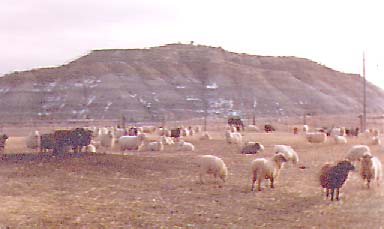
Return to Main Page.
Originally brought over by the Spaniards from Iberian stock in the sixteenth century; Churro sheep were a part of both the Spanish colonists' herds and the Southwest Native Americans' herds by the end of the 17th century. Navajos in particular became adept at using the animals for both food and fiber for weaving. Due to higher human populations and increased demands for wool products in the 19th century the Churros were mixed with other breeds. In 1863 the US Government carried out its first stock reduction of Navajo herds as punishment for resistance to the government. However some Navajos hid their sheep and later some relatively pure strains of Churros were found and bred beginning with the Navajo Churro Recovery Project in the late 1970's.
The Churro fleece is known for it's long, silky staple (length), ability to hold natural color and absorb dyes. The length of the Churro fleece makes for particularly soft and smooth weavings. The less oily coat (compared to other breeds) means less washing of the wool in preparation for weaving. In a desert climate this is a consideration as well. The Churros have a high rate of 'twinning' during lambing and on the whole they have an easier time lambing then some of the other breeds. The animals are efficient foragers and take advantage of the desert's shrubby growth. The meat is lean. The animals themselves are resistant to disease and tolerate the extreme climates of the Southwest.
The Navajos have always believed the art of weaving to be a gift from the Holy People. Before sheep were introduced; cotton and other fibrous plants provided the material for weaving. Today a renewed interest in the Churros is occurring as Navajos try to bring the Churros back to the Reservation. They are doing this by promoting the wool as a specialty wool for individual weavers and stressing the compatibility of the breed to the area. Our project is concerned with the time involved to replace our breeding herd stock with only Churros and the economic costs of doing so.
